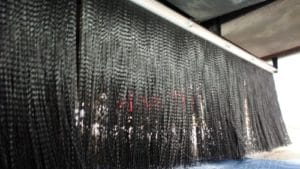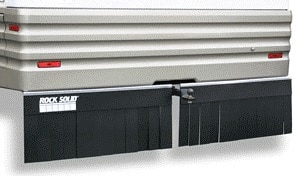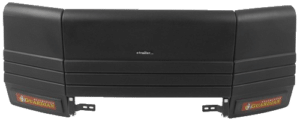Being able to tow another vehicle behind you is a significant advantage. You can set up and level your camper somewhere, but can still leave. The problem, however, is when taking in on the road. Figuring out ways to protect towed vehicle paint can help reduce damage to your towed car. All the rocks and dust you throw at your towed vehicle can cause not only cosmetic damage but mechanical too. Since the towed vehicle is attached so close to the camper the paint, grill, radiator, and windshield can easily be damaged.
There are many options to protect towed vehicle paint. Cars sit lower to the road and would benefit from a grill cover. While SUVs and crossovers sit higher behind the RV, they would benefit from protection mounted to the RV itself, like rock guards.
If you have ever been behind an 18-wheeler on the highway, you know that they can kick up dirt, dust, and most commonly, rocks. I have had many chips put in my windshield and nicks on the paint of the hood of my car from small debris. Mobile home or RV isn’t much different from an 18-wheeler when it comes to picking up debris.
Many different kinds of protection can be installed on the towed vehicle, RV, or a combination of both.
On RV Protection: Rock Guards
Essentially a flap that is placed behind the rear tires, covering the entire back end of the RV. These work well if you are towing larger vehicles like a crossover, SUV, Jeep, or small truck. There are several different options each with pros and cons. below are three different types of rock guards.
Solid Flap
This option is made out of one large piece of heaver rubber-like material. Not a whole lot is going to get past this, including water, dust, mud, and rocks. This option is best for RV owners who travel in colder climates with snow more often. Snow and ice have a hard time forming on this kind of flap.
This flap can and will make noise when the end of the camper gets too close to the ground. Another drawback is it may get in the way of your RV’s hydraulic level system if you have backed into a spot. They can quickly come on and off with a few chains that attach them to the RV.
The “Whisker” type

This type of rock guard looks similar to whiskers or eyelashes. They have hundreds of small thin brushes that work together to protect towed vehicle paint. While this one is the most aerodynamic, it falls short at what they need to do. Protect your vehicle. Larger rocks can easily pass through the whiskers. In colder climates, they can collect snow and ice between the small bristles. Hitting a bump with all that ice can knock it loose and cause problems for what you’re towing behind you.
Multiple Flaps

This option is very similar to the Solid flap as mentioned above. Multiple flaps fall right in between solid and whisker types. The critical difference is the flaps are broken up every 4-5 inches but still made of rubber. This allows air to pass through the flaps easier, but debris has a much harder time passing through than on whisker types. The multiple flaps can still collect ice and snow but not as much as the whisker rock guard.
On Vehicle Protection
This type is used to protect smaller vehicles like a car while towing it with an RV. These do not connect to the RV doing the towing. Instead, get attached to the vehicle being towed.
The Front Cover (Bra)
This type of protection is mounted on the front of the towed vehicle and secured tightly around the entire front bumper and grill. Some covers may cover part of or the whole hood of your vehicle.
This type can be left on and doesn’t require to be taken off when disconnecting from the tow bar. It can be a little unattractive, but it continues to work behind any vehicle on any road even when not being towed. Every so often a rock may get thrown above the cover hitting the exposed paint. It’s suggested to remove the cover once every few months to was out and dirt that got trapped under it.
Windshield Cover + Cardboard
The cheapest option I have come across so far. I’ve met people who tow a beater car that has more dents and scratches you can count. They buy a windshield cover usually to protect your car windshield from ice. It goes across the windshield and tucks into the door which you then shut. Then a piece of cardboard gets placed in the engine compartment in front of the radiator. This protects the cooling system from getting any leaks from a rock being thrown at the grill. Remember to take it out when you’re ready to drive your towed vehicle.
Tow bar Protection
Protecting the tow bar or the device that connects your vehicle to the RV is a great way to get a wide range of protection.
Horizontal tow bar Protection
This method works best for smaller vehicles. It’s attached below the tow bar assembly stopping rocks from coming up and hitting your vehicle. It does an excellent job without causing airflow issues. The hassle of laying down to remove and install the guard can get a little annoying. It can also be heavy if you get a rubber one.
Vertical tow bar Protection
This also attaches to your tow bar assembly but creates a wall in front of your towed vehicle. Larger vehicles will benefit from this the most. Unlike the horizontal tow bar, the vertical is made of screen or mesh to allow air to pass through it since it will be standing completely upright. It’s also lighter and more accessible to take on and off the tow bar. Of course, the debris can still be thrown over the vertical protection.
Tow Bar Sheild

While this kind almost connects to the Vehicle itself. It is still actually on the tow bar assembly. The shield is attached to the end of the towbar closest to your vehicle and covers only the front bumper and grill area. It does a good job of protecting the front bumper area but falls short protecting the windshield on vehicles that sit higher. They can hollow plastic and lite, making them easier to take on and off. Finally, some can fold for easy more compact storage.
Overall
There are several options available to protect towed vehicle paint. Some are better than others but come with trade-offs. I recommend a solid flap rock guard because it is a one-part solution. However, if you only camp in temped location, don’t want to re-attach protection every time you want to use your towed vehicle, or tow a car you don’t care gets some nicks then choose your option or options to protect your vehicle.

